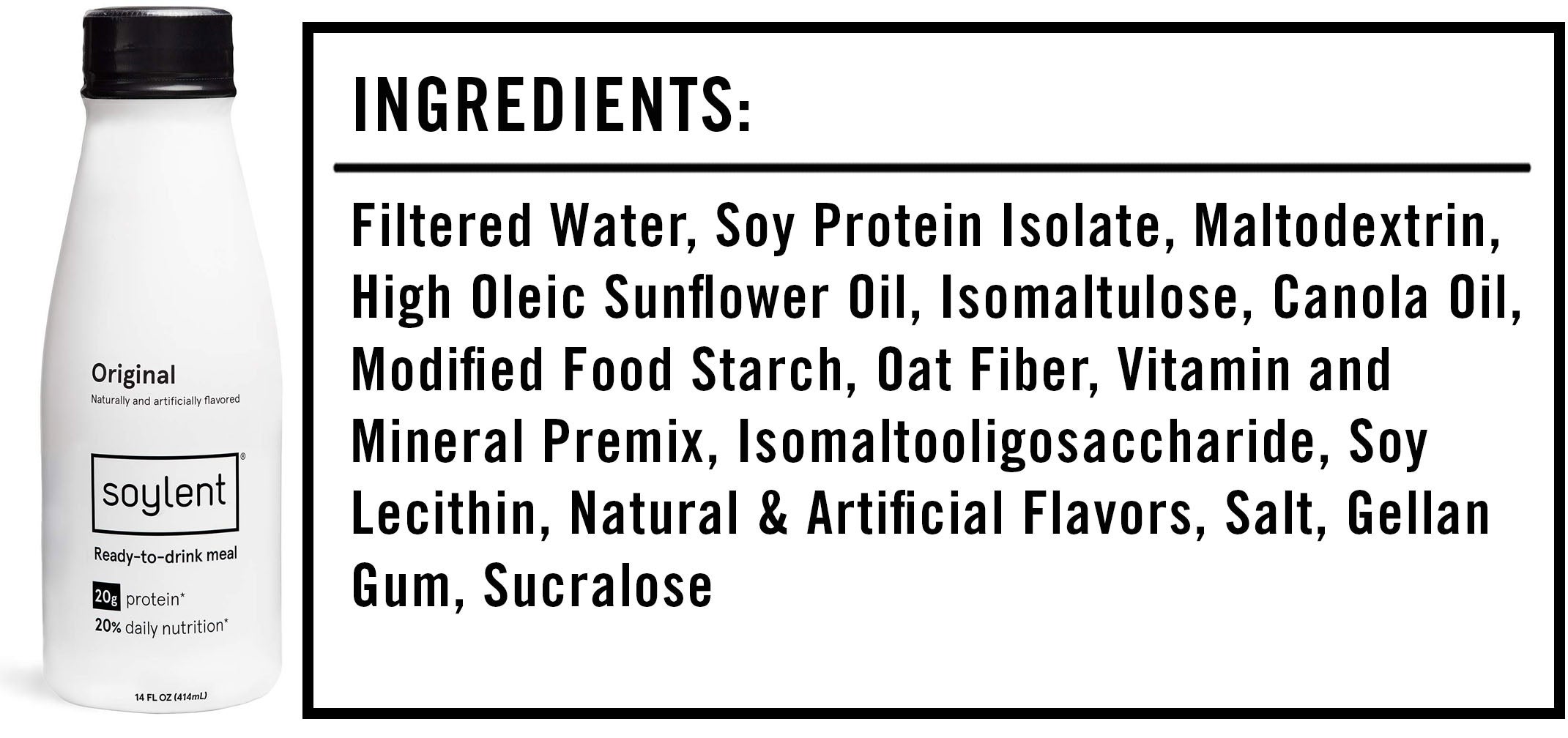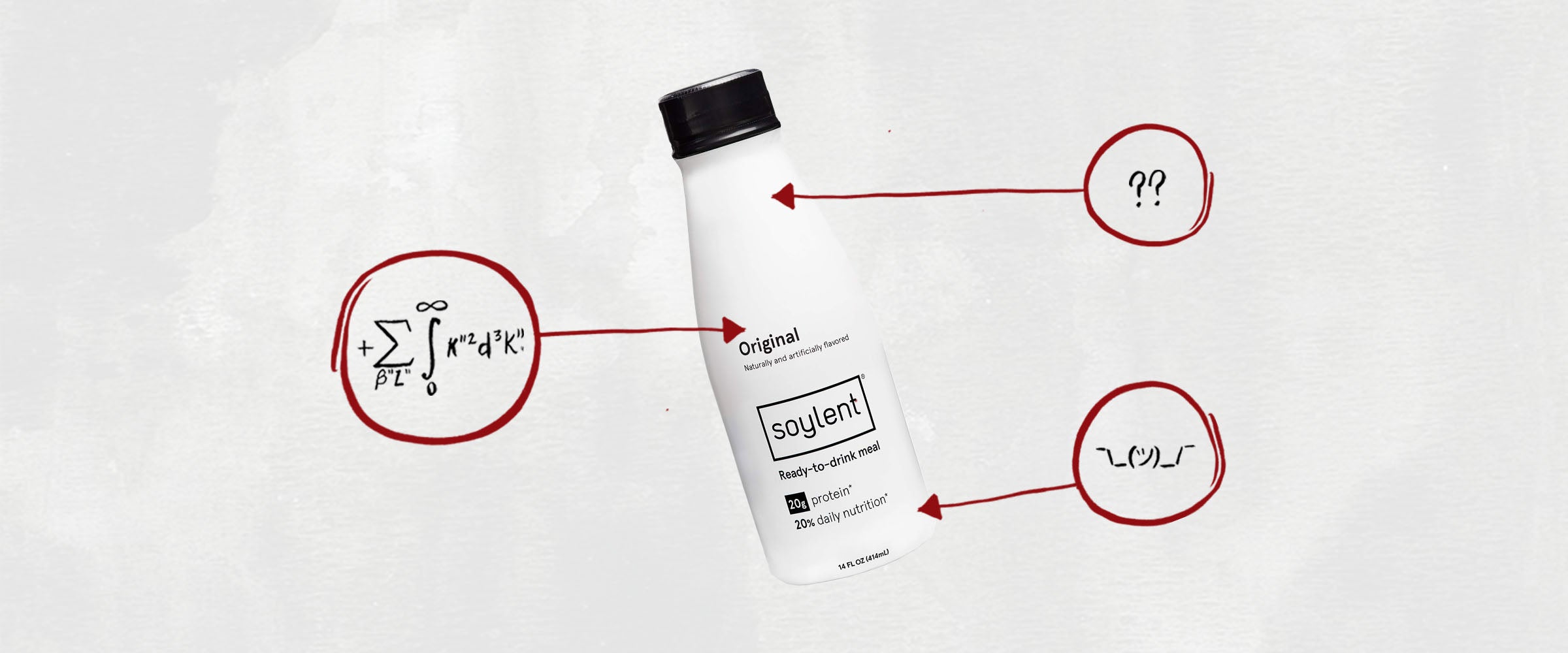We’re often told that you should never eat anything (or put anything on your body) if you don’t recognize everything on the ingredients list. But since most of us have no idea what xanthan gum or potassium benzoate are — or more importantly, what they’re doing to our bodies — we’re decoding the ingredients in the many things Americans put in (and on) themselves with the help of an expert.
This edition: Soylent, which is made from 41 separate ingredients that we’ve broken down in the exact order they appear on their website.

The Ingredients
1) Filtered Water: This acts as a base for the other ingredients.
2) Soy Protein Isolate: This is basically soybean flakes that have been dehydrated and ground into a powder; the result is primarily protein with a smattering of vitamins and minerals . It’s the main source of the 20 grams of protein found in a bottle of Soylent. (For comparison’s sake, that’s the same amount of protein found in a quarter-pound beef patty.)
3) Maltodextrin: An artificial sugar made from maltose (aka malt sugar) and dextrose (a sugar derived from starches), maltodextrin is usually used as a thickener or filler ingredient to add bulk to processed food and to increase its shelf life. (Maltodextrin itself has a shelf life of two years.)
4) High Oleic Sunflower Oil: High oleic sunflower oil, compared to regular sunflower oil, is particularly high in monounsaturated fats, which lower cholesterol, and therefore, reduce your risk of heart disease and stroke. So this is basically the healthiest version of sunflower oil.
But of course, there’s a catch: Physician and biochemist Cate Shanahan, author of Deep Nutrition: Why Your Genes Need Traditional Food, previously told me that consuming too much vegetable oil (canola, sunflower or corn) — which is easy to do, considering Shanahan says roughly 45 percent of the average American’s calories come from refined oils — has serious repercussions (i.e., fatty liver disease, insulin resistance and migraines). While it’s nearly impossible to eliminate vegetable oil from your diet altogether — major contributors include processed foods, fried foods, frozen pizzas, cakes, cookies, margarines and coffee creamers — it’s best consumed in moderation.
5) Isomaltulose: Similar to maltodextrin, isomaltulose is another sugar alternative, and studies show that it’s generally safer than table sugar, since it doesn’t cause as much of a spike in blood sugar.
6) Canola Oil: See high oleic sunflower oil.
7) Modified Food Starch: Modified food starch is extracted from the source (corn, potato, tapioca, rice or wheat), then treated physically, enzymatically or chemically to partially break down the starch. It’s typically used to add bulk.
8) Oat Fiber: Oat fiber is made from grinding the hull of oats, which have been separated from the kernels. That means oat fiber is, for all intents and purposes, added fiber.
9) Vitamin and Mineral Premix: There are tons of vitamins and minerals in Soylent, which we’ll cover below.
10) Isomaltooligosaccharide: This is a sweet-tasting source of prebiotic fiber, and while it has been touted as a generally healthy ingredient — especially in energy bars and meal replacement drinks — some studies suggest that it can cause unhealthy spikes in blood sugar.
11) Soy Lecithin: Soy lecithin is a component of fat found in — you guessed it — soy. It’s typically added to food products as an emulsifier. In simpler terms, it helps the numerous ingredients found in Soylent mix together.
12) Natural and Artificial Flavors: While natural flavors are quite literally flavors derived from an actual food source — i.e., vanilla flavoring taken from real vanilla beans — artificial flavors are chemical compounds created in a lab that mimic a natural flavor in some way. While that may sound unnatural (and thus, unhealthy), Shanahan has no real problem with artificial flavors: “They’re not killers because they’re added in very, very small quantities to food.”
13) Salt: The body needs sodium, and since Soylent is meant to be a meal replacement drink, it should contain at least some salt.
14) Gellan Gum: This is a thickening agent.
15) Sucralose: This is yet another artificial sweetener, more commonly known as Splenda. In addition to all the other problems posed by artificial sugars, studies suggest that sucralose in particular increases the populations of bacteria in our gut that pull energy from our food and turn that energy into fat. Or in simpler terms, sucralose may make us gain weight.
The Vitamin and Mineral Premix
1) Potassium Chloride: Potassium chloride is added to food for two reasons: 1) To act as a salt substitute; and 2) to enhance the amount of potassium — an essential and widely under-consumed nutrient — found in the product. While small amounts — like that found in Soylent — shouldn’t do you any harm, nutritionist David Friedman, author of Food Sanity: How to Eat in a World of Fads and Fiction, previously told me that consuming too much of the stuff is a bad idea. “Potassium chloride is used to induce cardiac arrest during executions by lethal injection,” he says. “That should speak volumes as to whether this ingredient belongs in our food supply.”
That said, Dagan Xavier, ingredient expert and co-founder of Label Insight, told me that you shouldn’t be too concerned, though: “Potassium Chloride has a very bitter taste, and therefore, overuse is unlikely within our food supply.”
2) Magnesium Phosphate: This ingredient functions as an antioxidant, an acidity regulator and an anti-caking agent. It also can be used as a laxative, which means large amounts can (and will) induce diarrhea and vomiting.
3) Tricalcium Phosphate: Tricalcium phosphate acts, more or less, as a bulking ingredient. One study from the American Thoracic Society found that a diet high in inorganic phosphates, like tricalcium phosphate, may accelerate the development of lung cancer; however, there probably isn’t enough tricalcium phosphate in Soylent to cause you any real problems.
4) Dipotassium Phosphate: “Dipotassium phosphate is an acidity regulator, antioxidant, sequestrant [a food additive which improves the quality and stability of foods] and stabilizer,” Xavier previously told me. Studies suggest that those with kidney disease should monitor their dipotassium phosphate intake, as too much phosphorus in the blood can contribute to bone and heart disease and make kidney disease worse.
5) Choline Chloride: Also known as vitamin B4, this may help with age-related memory loss.
6) Sodium Ascorbate: This is more or less just a fancy name for vitamin C.
7) DL-Alpha-Tocopheryl Acetate: This is an antioxidant that can protect the body from free radical damage.
8) Ferrous Gluconate: This prevents low levels of iron in the blood, which in turn helps the body produce red blood cells.
9) Zinc Sulfate: This supports the immune system.
10) Niacinamide: This improves cholesterol levels and lowers cardiovascular risks.
11) D-Calcium Pantothenate: This converts carbohydrates and fats into energy.
12) Vitamin A Palmitate: This supports vision and the immune system.
13) Thiamine Hydrochloride: This helps the body break down carbohydrates.
14) Copper Gluconate: Similar to ferrous gluconate, this helps the body produce red blood cells.
15) Manganese Sulfate: This support the metabolism and regulates blood sugar.
16) Pyridoxine Hydrochloride: This helps the brain create serotonin (which regulates mood) and norepinephrine (which helps the body cope with stress).
17) Riboflavin: Also known as vitamin B2, riboflavin helps the body break down food to produce energy.
18) Chromium Chloride: This can help treat diabetes and promote weight loss.
19) Biotin: This strengthens hair and nails.
20) Folic Acid: This helps your body produce and maintain new cells and prevents changes to DNA that may lead to cancer.
21) Sodium Molybdate: This is a chemically altered form of sodium, and it can help correct sodium deficiencies.
22) Sodium Selenite: This is a form of selenium, which is an antioxidant.
23) Vitamin K1: This helps with blood clotting.
24) Potassium Iodide: This protects the thyroid, which regulates all sorts of bodily functions.
25) Cyanocobalamin: This is another version of vitamin B12, which keeps the body’s nerve and blood cells healthy.
26) Ergocalciferol: Also known as vitamin D2, this helps the body absorb calcium.
The Takeaway
Here’s the deal: Meal-replacement drinks like Soylent contain essential vitamins, minerals and fiber, which many Americans simply don’t get enough of. Therefore, in a pinch, Soylent is certainly a healthier option than, say, a bunch of junk food.
That said, most meal-replacement drinks, including Soylent, essentially isolate a bunch of vitamins and minerals, but they lack the healthy compounds that would otherwise be found in actual whole foods — something I’ve been warned about, time and again. In other words, whole foods do much more for your health than the sum of their parts, which means living strictly off soylent probably isn’t the absolute healthiest option (plus, drinking all your calories totally sucks).
Again, though, the occasional Soylent is a good way to beef up your diet and certainly a better choice than junk food. So overall, Soylent is a pretty solid dietary supplement — just don’t live off of it.

